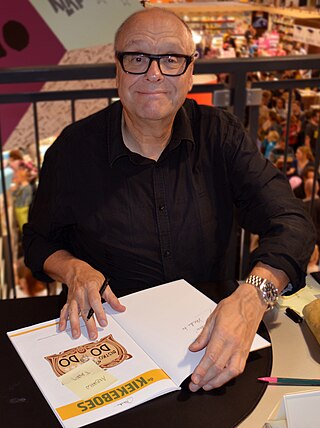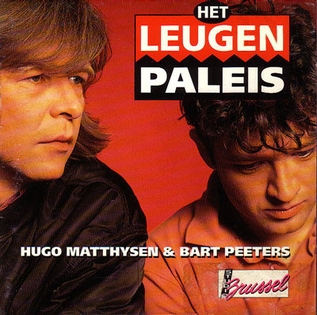Concept
Het Manneke was a series of slapstick sketches starring Flemish comedian Jef Cassiers as the titular character. Cassiers always wore a long coat, a black hat, a long scarf and frequently carried a ladder around. [1] Most sketches centered only around him, though his brother Cois Cassiers and Doris Van Caneghem sometimes had supporting roles. All episodes were directed by Herman Wuyts. [2]
On the BRT the episodes were used as a bumper before their news reports started. [3]
In 2012 the old episodes were rebroadcast on New Year's Eve, after the BRT organized a viewer's poll to find out which of their old shows ought to be rebroadcast during that special time of the year. "Het Manneken" surprisingly ended first place. [4]
The year 1955 in television involved some significant events. Below is a list of television-related events during 1955.

Vlaamse Radio- en Televisieomroeporganisatie, commercially styled as VRT is one of the national public service broadcasters for the Flemish Community of Belgium.

VTM or Vlaamse Televisie Maatschappij is the main commercial television station in Flanders and forms part of a network of channels owned by DPG Media.

Brother Dr. René P. E. Stockman, F.C. is the Superior General of the Congregation of the Brothers of Charity from 2000 to July 09, 2024. He is a Belgian specialist in psychiatric caregiving.
Ultratop is an organization which generates and publishes the official record charts in Belgium. Ultratop is a non-profit organization, created in 1995 on the initiative of the Belgian Entertainment Association (BEA), the Belgian member organization of the International Federation of the Phonographic Industry. Two parallel sets of charts are concurrently produced and published; one is on behalf of Belgium's mainly Dutch-speaking Flanders region, and the other catering to the nation's mainly French-speaking region of Wallonia.

Mark Uytterhoeven is a Belgian television presenter, TV scriptwriter, actor, comedian and former sports journalist.

Merho, is a Belgian comic-book writer and artist, best known for creating the comic strip De Kiekeboes.

Hippoliet Jan Van Peene was a Belgian physician and playwright.

Uitgeverij Lannoo Groep is a Belgian publishing group, based in Tielt, with assets in Belgium and the Netherlands. Its Belgian subsidiary is Uitgeverij Lannoo. Its Dutch subsidiary is LannooMeulenhoff. Over the years Lannoo evolved from Catholic and Flemish to an open, commercial publishing house.

Het Leugenpaleis was a Flemish (Belgian) radio sketch comedy show by Hugo Matthysen and Bart Peeters, presented from 1988 until 1999 on radio station Studio Brussel. At the time it enjoyed a huge cult following.
Radio2 is a Belgian radio channel operated by the Flemish public broadcaster Vlaamse Radio- en Televisieomroep (VRT).

Gaston Petrus Bernardina Berghmans was a Belgian actor and comedian. Between 1972 and 1993 he and Leo Martin formed a comic duo called Gaston and Leo.
André Leopold Adiel Vermeulen is a Belgian-Flemish journalist and television personality for VRT.
Tik Tak is a Belgian baby show television series, the series aired on BRTN from 1 November 1981 to 1991 and CBeebies in 2020.

Claire Vanhonnacker, also known by her artist name Claire, was a Belgian singer. She is best known for her Dutch interpretation of Larry Weiss’ Rhinestone Cowboy as ‘Vreemde Vogels’ and ‘Op de purp’re hei’. She lived in Deerlijk.

Schipper naast Mathilde was a Flemish TV sitcom, broadcast between 1955 and 1963 on the Flemish public service TV station N.I.R.. At the time it was tremendously successful and it is well regarded as the first classic TV series of Flemish television. About 185 episodes were made, but since many of them went live in the air without recording a copy the majority are lost today. Another part was lost in a fire. In 2005 a DVD was made available which contains all the remaining episodes, nine in total.

100.000 of niets was a Flemish television quiz show on the Flemish public broadcaster N.I.R., between 1956 and 1959. It was one of the most popular television shows from the Flemish pioneer years.
Wij, Heren van Zichem was a Flemish TV drama series, originally broadcast between 1969 and 1972 in 26 episodes on the BRT. The program was based on several novels by Ernest Claes, who died just a few months before the show first aired. All episodes were shot in the Flemish village Zichem. At the time it was one of the most popular TV series in Flanders, attracting almost 2,960,000 viewers which is about 3/4 of all Flemish people. Tourism to the village boomed, while it hardly had enough bars, let alone restaurants to accommodate the tourists. In a 2004 interview with Het Nieuwsblad actor Fons Exelmans remembered that tourists were often confused because certain houses and buildings were located less close to each other than in the series. The actors were also invited to appear during annual festivities as promotional stunts.
Kom Toch Eens Kijken was a Flemish children's TV series, broadcast between 1955 and 1960 on the Flemish public TV channel NIR 1. It was hosted by Bob Davidse and Terry Van Ginderen, who both presented themselves to their young viewers as Nonkel Bob and Tante Terry.
The second season of the Belgian Dutch-language television mystery music game show I Can See Your Voice premiered on VTM on 2 September 2022.
This page is based on this
Wikipedia article Text is available under the
CC BY-SA 4.0 license; additional terms may apply.
Images, videos and audio are available under their respective licenses.












